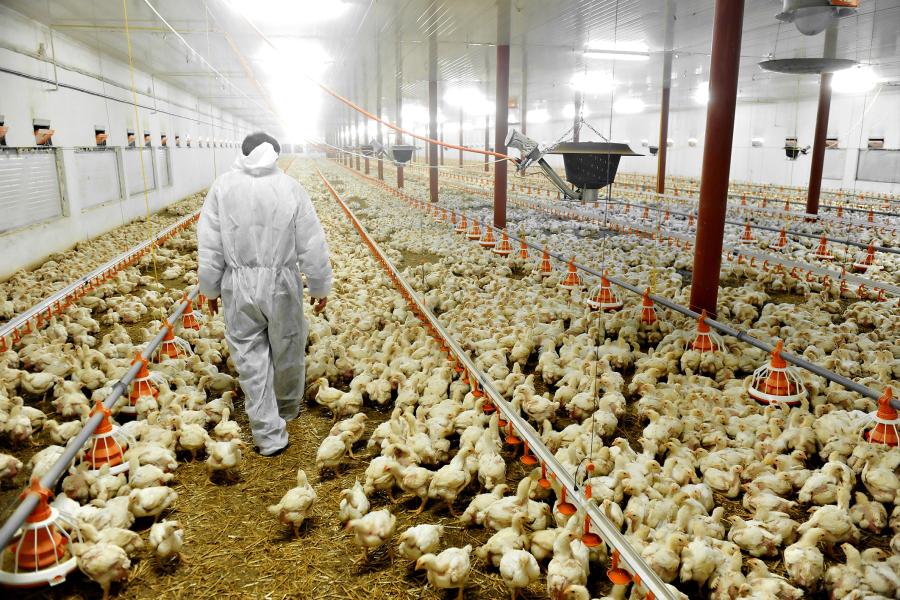Chicken, ‘Poultry Farm And A Veterinary’, 2025, roibu

Species: Chicken, Gallus gallus domesticus
Location and habitat: Global
Conservation Status: Least Concerned
Title: 'Poultry Farm And A Veterinary'
Creator: roibu
Date: 2025
Medium: Photography
Copyright: Via Adobe Stock
Ancient Romans had a practice called 'alectryomancy' which involved the use of a sacred rooster as a medium for divination, believing it could communicate with the gods and could predict the future. Perhaps a particularly clear sighted cock could have seen an archaeologist working in the distant future, maybe millions of years away, looking back at the 20th/21st Century and trying to figure out what went wrong. One of the biggest traces left of our present day world will be a ridiculously gargantuan number of fossilised chicken bones.
The story starts long before then: around 8,000 years ago, the ground-dwelling tropical bird -- now known as the Red Junglefowl (*Gallus gallus*) -- first become domesticated somewhere in South-East Asia. From there, these proud and beautiful birds spread slowly around the world, delivering primarily eggs and secondarily meat (only from males and post-laying hens, and only on special occasions), as well as innumerable cultural significance to peoples across the world, featuring widely in folklore, religion and literature -- including the clairvoyant cocks mentioned above. The relationship between humans and chickens changed sharply in the mid-20th Century with the rise of global technoscientific capitalism.
In 1945, the US government announced a competition to breed the 'Chicken of Tomorrow', with this coming about via a set of brutal, industrial and utterly rationalised practices that created the 'broiler' chicken, a novel morphotype that enables a meat production system that transforms a fertile egg and 4kg of feed into 2kg of chicken meat in just 38 days. Their lives begin with artificial insemination and artificial incubation, before they spend the five weeks of their lives indoors, heated, under artificial lights, in barren rooms in extreme density: the EU regulates that density of '42 kg/m2', that's 21 birds per square meter). Considering this massive density and the thoroughly monocultural breeding stock, broilers are highly vulnerable to infection, and are thus preemptively and routinely fed vaccines and antiboiotics. In the last quarter of their 38 day life, broilers spend the vast majority of their time inactive, largely for the sheer cardiovascular strain of pumping so much blood into an gargantuan breast muscle. Broiler's body mass has increased five fold since 1945. Once their 38 days are up, around 90% are subject to 'live-shackle slaughter', a process by which live birds are hung by the feet, dipped into an electrified bath, have their throats slit and bleed, before being immersed in boiling water. All the human labour of this process is performed by extremely exploited workers: in the US, only about two cents from every dollar spent on fast food chicken goes to the poultry workers. The sheer scale of this practice is mind boggling. At any one time, there are around 33 billion chickens globally, with them having a biomass three times more than all wild birds combined. In 2018, global factory farms slaughtered around 68,795,221,000 broilers for meat: that's over 188 million per day, up three fold since 1991.
Returning to our thought experiment of a future archaeologist digging through the ruins of our world -- as possibly glimpsed by a sacred Roman oracle rooster. They would uncover enormous numbers of broiler bones, and would no doubt note the morphotype's altered skeletal structure, bone geochemistry, pathologies and stunted genetic diversity as being all very distinct from the birds ancestors. As such, the broiler chicken is a powerful material symbol of the unprecedented reconstitution of the Earth by the forces of technoscientific capitalism. Indeed, countless chicken fossils will be one of our biggest contribution to the long-term future of the planet -- along with the fossil traces of many many other species abruptly ending in the Sixth Mass Extinction.
Quotes
No quotes found.
Login to add a quote